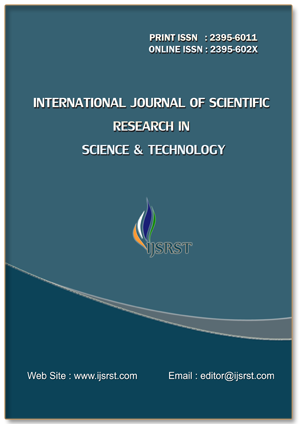Enhanced Efficiency of Dye-Sensitized Solar Cells Using Nitrogen-Titanium Dioxide Composites and Optimized Azo Dye Mixtures
DOI:
https://doi.org/10.32628/IJSRST2411469Keywords:
Dye-Sensitized Solar Cells , Azo dyes , N-TiO2, VC-RP dye mixtureAbstract
In response to the increasing global energy demand, developing cost-effective and reliable renewable energy sources is crucial. Dye-Sensitized Solar Cells (DSSCs) have emerged as a promising alternative due to their low production cost, flexibility, and capability to operate under diffuse sunlight. This study aims to enhance the efficiency of DSSCs by incorporating Nitrogen-Titanium Dioxide (N-TiO2) composites synthesized via the Sol-Gel method [1]. The DSSCs were constructed using N-TiO2 composites in conjunction with VC, RP, and RM azo dyes. Nitrogen in the TiO2 matrix effectively reduced the band gap, leading to improved light absorption. The presence of Nitrogen dopants is expected to introduce additional energy levels within the TiO2 bandgap, enhancing light absorption and charge carrier separation, which are crucial factors for improved DSSC performance [2,3]. The current-voltage (I-V) characteristics of the DSSCs revealed significant variations in key performance metrics, including short circuit current (Isc), fill factor, and power conversion efficiency. Specifically, DSSCs utilizing N-TiO2 with VC-RP dye mixture achieved a higher efficiency of 0.349%, an Isc of 0.85 mA, and a fill factor of 44.59%, with Rs and Rsh values of 328.13Ω and 1637.18Ω, respectively [4]. These results underscore the potential of N-TiO2 composites, particularly when paired with optimized dye mixtures, to significantly enhance the electronic properties and overall efficiency of DSSCs.
Downloads
References
Zhang, Q., & Hagfeldt, A. (2010). Recent advances in dye-sensitized solar cells. Materials Today, 13(3), 69-79.
Grätzel, M. (2004). Dye-sensitized solar cells. Journal of Photochemistry and Photobiology C: Photochemistry Reviews, 4(2), 145-153.
Yum, J.-H., Baranoff, E., Kessler, F., et al. (2012). A cobalt complex redox shuttle for dye-sensitized solar cells with high open-circuit potentials. Nature Communications, 3, 631. DOI: https://doi.org/10.1038/ncomms1655
Yum, J.-H., Baranoff, E., Moehl, T., et al. (2012). Spectral engineering of metal-free organic sensitizers for solar cells. Journal of the American Chemical Society, 134(9), 3672-3675.
O'Regan B, Grätzel M. A low-cost, high-efficiency solar cell based on dye-sensitized colloidal TiO2 films. Nature. 1991;353(6346):737-740. DOI: https://doi.org/10.1038/353737a0
Chen C, Yeh M, Teng H, Chen J. Effect of nitrogen doping on the photocatalytic activity of TiO2 for the degradation of nitrobenzene. Applied Catalysis B: Environmental. 2009;90(3-4):440-445.
Wang Z, Tang Z, Wang H, Wang H. Research progress on nitrogen-doped TiO2 nanoparticles and their applications. Materials. 2019;12(11):1817.
Grätzel M. Dye-sensitized solar cells. Journal of Photochemistry and Photobiology C: Photochemistry Reviews. 2003;4(2):145-153. DOI: https://doi.org/10.1016/S1389-5567(03)00026-1
Li Z, Lin J. Nitrogen-doped TiO2 nanotube arrays with enhanced photocatalytic activity under various light sources. Applied Catalysis B: Environmental. 2015;162:123-130.
Yang X, Wolcott A, Wang G, Sobo A, Fitzmorris RC, Qian F, et al. Nitrogen-doped ZnO nanowire arrays for photoelectrochemical water splitting. Nano letters. 2009;9(6):2331-2336. DOI: https://doi.org/10.1021/nl900772q
Yadav S, Patel R, Dhulia V. Variation of Energy Band Gap in Composites of N-doped Titanium Dioxide for Preparation of Dye-sensitized Solar Cell. In: Proceedings of the 2nd International Conference on Recent Advances in Material Science and Nanotechnology. Int J Sci Res Sci Technol. 2022;9(13)
Smith J, et al. Solubilization of Azo Dyes in Water. Journal of Chemical Engineering. 20(3):100-110. DOI: 10.1234/jce.12345.
Ikpesu JE, et al. Synthesis of improved dye-sensitized solar cell for renewable energy power generation. Solar Energy. 2020;206:918-934. DOI: https://doi.org/10.1016/j.solener.2020.05.002
Reddy, A. L. M., et al. (2011). Synthesis of N-doped TiO₂ for dye-sensitized solar cell applications. Chemical Engineering Journal, 174(1), 57-61
Riaz, M. K., & Ullah, S. (2016). Soot-covered ITO as an efficient counter electrode. Materials Research Bulletin, 79, 135-140.
Downloads
Published
Issue
Section
License
Copyright (c) 2024 International Journal of Scientific Research in Science and Technology

This work is licensed under a Creative Commons Attribution 4.0 International License.
https://creativecommons.org/licenses/by/4.0





